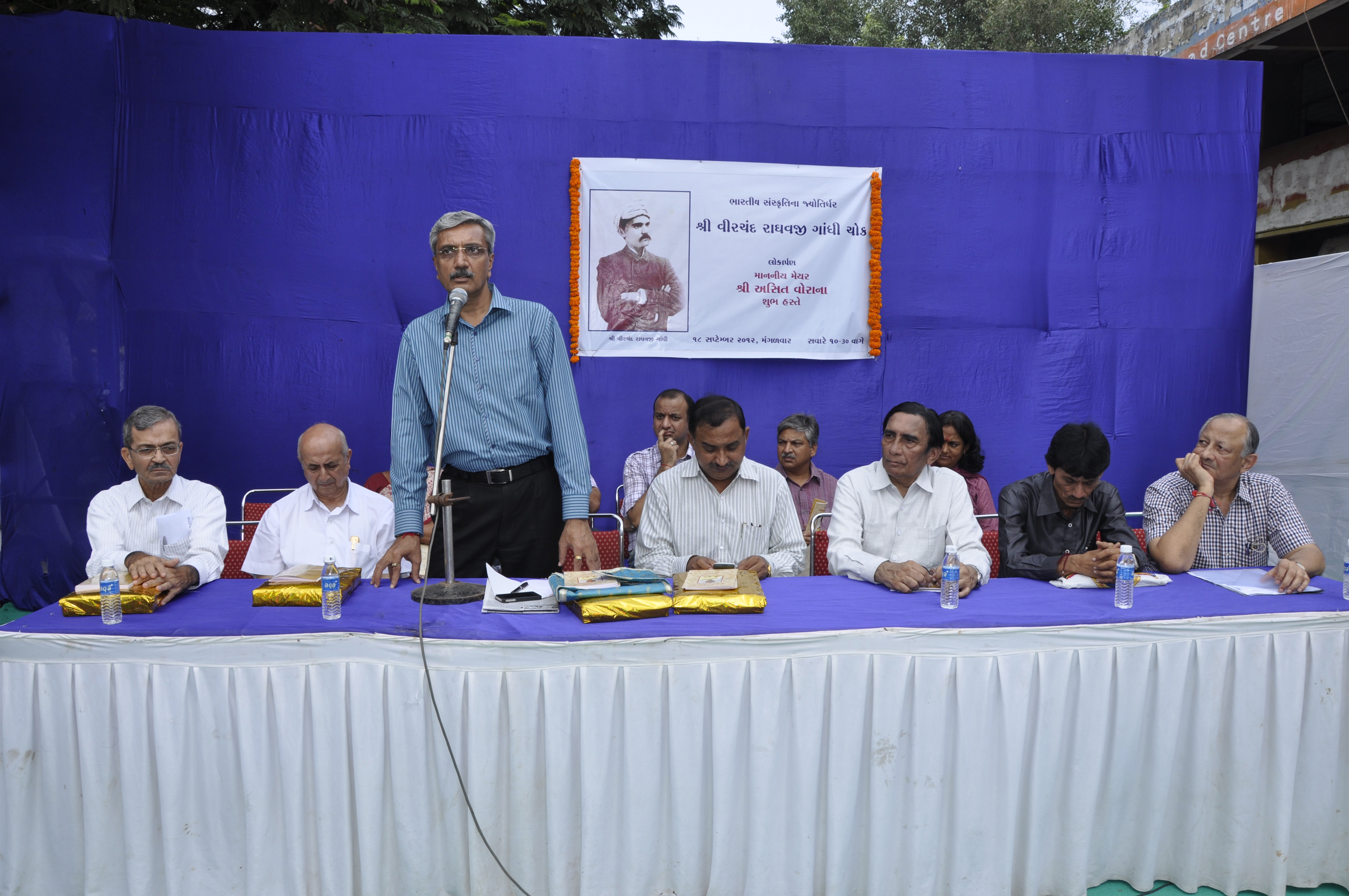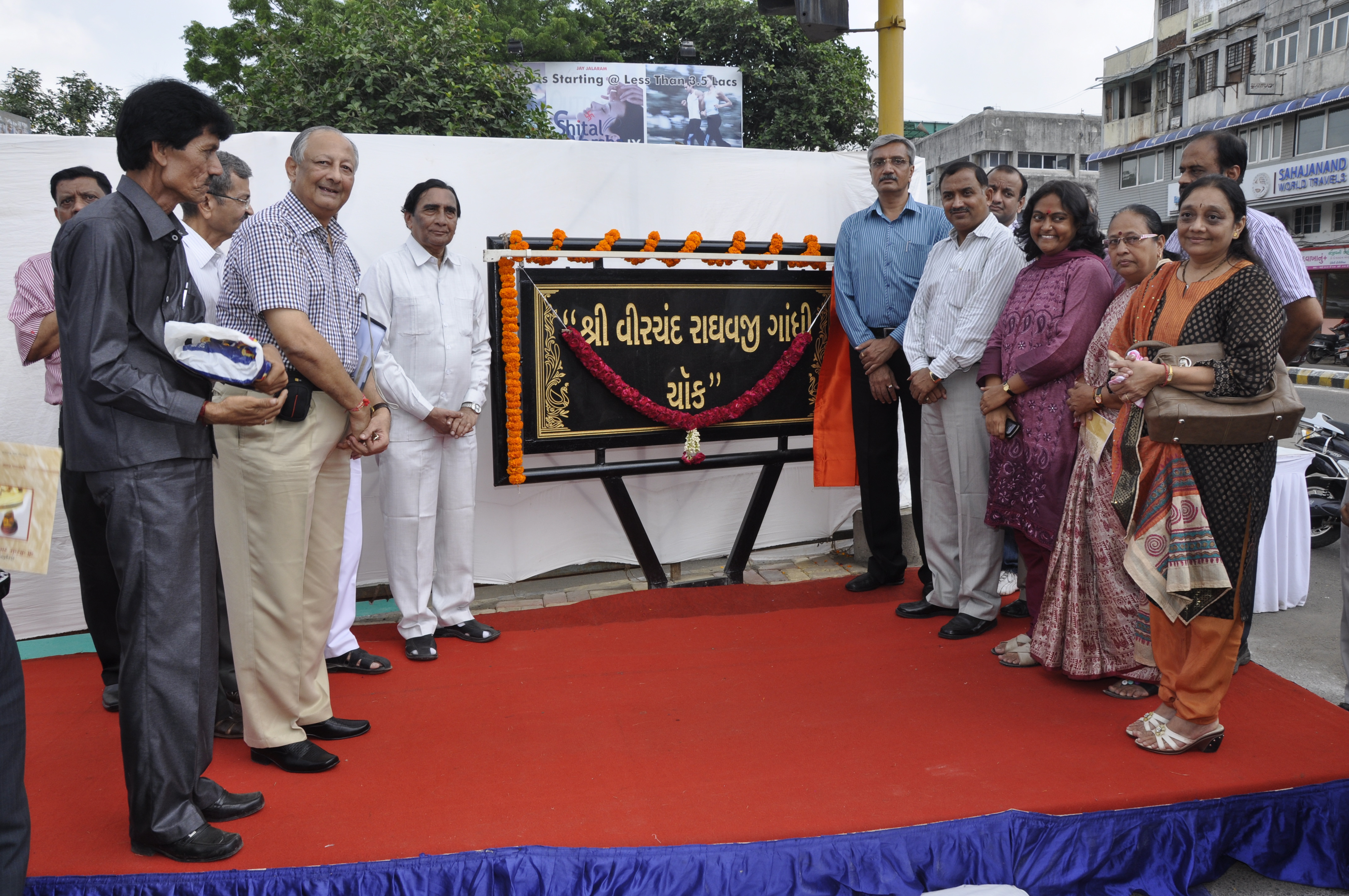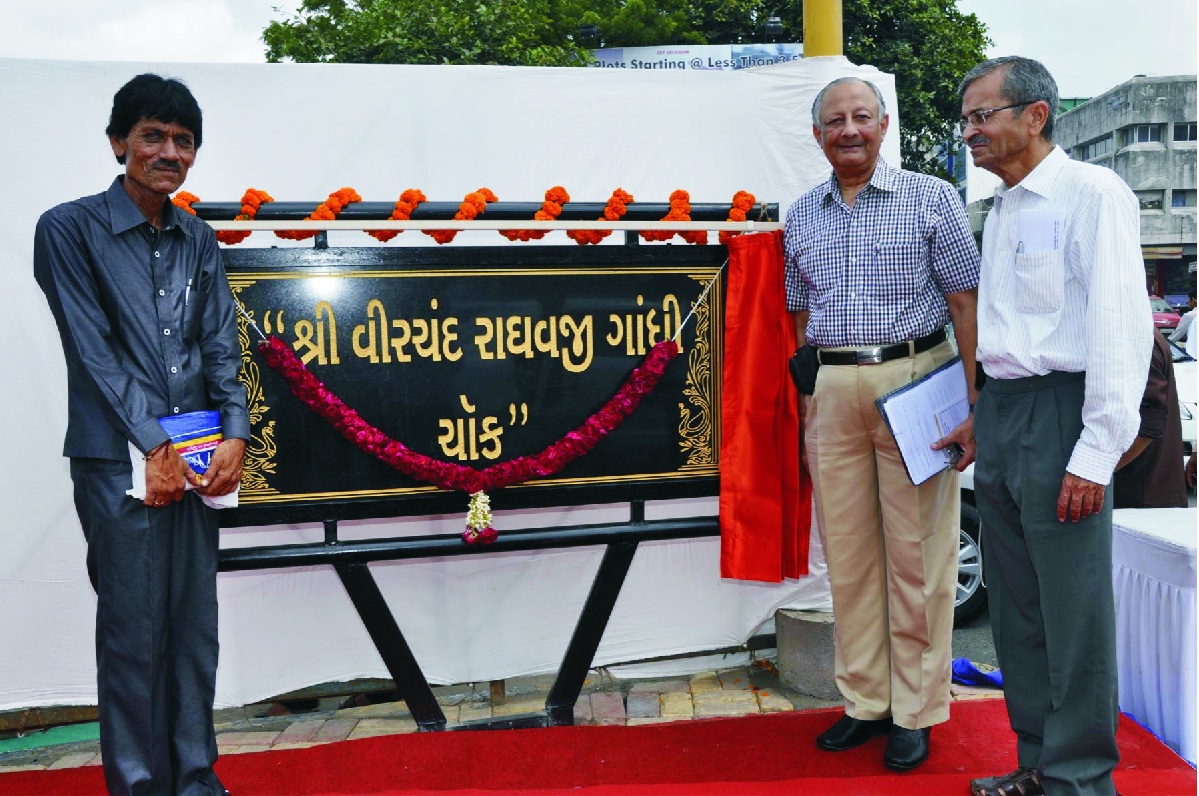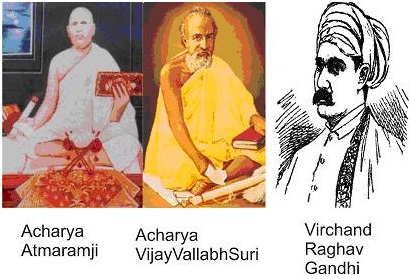
Institute Of Jainology
Ahmedabad 19th September 2012
A public square in Narangpura suburb of Ahmedabad was renamed to commemorate the name of the torchbearer of Indian culture and heritage Shree Virchand Raghavji Gandhi. This was achieved through the efforts of the Institute of Jainology which has been promoting the awareness of Jain philosophy internationally for over 20 years.
Mayor of Ahmedabad, Honourable Shree Asitbhai Vora when naming the square said the V R Gandhi’s achievements are a matter of pride for all Indians. The work he did in America with Swami Vivekanandji is truly unforgettable. His lectures introduced the real culture and heritage of India for the first time internationally at the World Parliament of Religions in Chicago and later in other cities in the US and also in England. Our future generations will certainly be able to take pride from his achievements.

Mayor Asitbhai Vora Addressing the Gathered Public
MLA Shree Rakeshbhai Shah in his address said that by giving recognition to the person who brought to light the greatness of Jain philosophy and culture Ahmedabad Municipal Corporation has made itself great. He commended the Institute of Jainology for bringing out the achievements of great but forgotten personalities like V R Gandhi. This would be of very beneficial to both the community and the nation.

From the left: Mr Chandresh Gandhi, Mr Maheshjumar Gandhi, Dr Kumarpal Desai, Mr Asitbhai Vora, Mr Rakeshbhai Shah with other guests
Dr Kumarpal Desai, Managing Trustee of Institute of Jainology, India who described V R Gandhi as a companion of Swami Vivekanandji and a friend of Mahatma Gandhi and said that both in the US and in England he had given over 535 lectures on Jain philosophy, yoga, meditation, importance of a cow, Indian women, vegetarianism and on other religious systems like Sankhya and Vaisheshik prevelant in India. In those days India was better known for tigers, cobras and maharajas and he created an awareness of Indian civilisation, richness of its culture and its history.

Displaying a commemorative booklet on Shree V R Gandhi
A goodwill message from the Chairmanemeritus of the Institute of Jainology, Shree Ratilal P Chandaria was also read out. Several Jain Acharyas spending their monsoon locally had also sent goodwill messages.
Chandresh Gandhi, grandson of Shree V R Gandhi, recalled some memorable incidences from latter’s life. Shree Maheshkumar Gandhi, a Patron of the Institute had come from Mumbai and expressed his thanks to all those who had helped to make this a reality.
Many leading members of the Jain and wider community including Shree Arvindbhai Doshi, Shree Shriyakbhai Arvindbhai, Jayantibhai Sanghvi, Mahendrabhai Shah, Shree Nagarajaji Chajer were presentduring the ceremony. Well known literary writers like Smt Anila Dalal and Rajendra Patel were also present.

Mr Chandresh Gandhi, Mr Maheshkumar Gandhi & Mr Arvindbhai Doshi
The Institute of Jainology was also instrumental in getting a bust of Shree V R Gandhi installed in Jain Centre Chicago in 1993 to commemorate the centennial anniversary of the first World Parliament of Religions in 1893.
Shri Virchand Raghavji Gandhi: Biography & History in Brief
He was the first Jain to travel outside India to participated in the first Parliament of World Religions held in Chicago in 1893 on recommendation of Acharya Vijayandsuri. The second Parliament was also held in Chicago in 1993 to which the Institute had led a Jain delegation. Indian Posts have decided to issue a dual commemorative stamp worth Rs 5/- each on 25th August 2009. This means that two of The Institute is happy to have been of support to organisations which had requested this issue.
Thus two of Acharya Vijayanandsuri’s disciples are being honoured by the Indian Government in the year 2009.
In view of the immense contribution made by Virchand Raghavji Gandhi to create a worldwide awareness of the Jain philosophy, we are pleased to include in detail his achevements in the United States.The research was undertaken by Pankaz Chandmal Hingarh of JAINA.
Acharya Vijayanandsuriji (Atmaramji Muni), a versatile, far-sighted Jain saint-scholar, author of several learned treatises was invited to participate in first ever the Parliament of World Religions at Chicago, USA in 1893. Code of conduct for a Jain monk prevented him from going abroad.
However, he was monk with a great vision for the future and realised that the Parliament for the World religions would provide a great platform to create an awareness of Jain philosophy worldwide.
He trained and deputed 29 year-old, charismatic Virchand Raghavji Gandhi to represent Jain faith at the World Parliament.
Virchand Gandhi (August 25, 1864 - August 7, 1901). was a young barrister, great exponent of Indian culture-religions, a multilingual person having learnt 14 languages, secretary of Jain Association of India, Mumbai. He was well-versed in Jainism, Buddhism, Hinduism, Christianity, Western philosophies, Yoga, etc.
Its note worthy that he had become first Hon. Secretary of Jain Association of India in 1885, at a very young age of 21,
VRG and Swami Vivekananda sailed at the same time to participate at the Parliament with same goals; both personalities wearing traditional turbans, made tremendous appearance and had claimed equal attention at the Congress for awakening the western world of the spiritual heritage and rich past history of India. Shri Virchand Gandhi’s life was full of incidents and events, which were rare, even in the life of great personages of those times.
1893, World Religions parliament was held at the Columbus Hall of Art Institute of Chicago with more than 3000 delegates of different nations and religions & such conference lasted for 17 days.
VRG, at the Parliament of World Religions conveyed, “You have heard so many speeches from eloquent members, and I shall speak later on at some length. I will, at present, only offer on behalf of my community and their high priest, Muni Atmaramji, whom I represent here.,Our sincere thanks for the kind welcome you have given us.
This spectacle of learned leaders of thought and religion meeting together on a common platform and throwing light on religious problems has been a dream of Muni Atmaramji’s Life. He has commissioned me to say to you that he offers his most cordial congratulations on his own behalf, and on behalf of the Jaina community, for your having achieved the consummation of that grand idea, of convening a Parliament of Religions.
I wish that the duty of addressing you on the history and the tenets of the Jaina faith had fallen on that able person than on me. The inclemency of the climate, and the distant voyage which one has to undertake before one can come here, have prevented that able Jaina from attending this grand assembly and personally presenting to you the religious convictions of the Jainas.
You will, therefore, look upon me as simply the mouthpiece of Muni Atmaramji, the learned high priest of the Jainas in India, who has devoted his whole life to the study of that ancient faith. ”.
“I represent Jainism, a faith older than Buddhism, similar to it in its ethics, but different from it in its psychology, and professed by a million and a half of India’s most peaceful and law abiding citizens”. He expounded to them what this universe is; whether there is God as the creator of this universe; what is the ultimate purpose of life and several such other things. He explained to themnavatatva, shaddravya, chargati, panchavratha, Moksha, nyayavad, Anekanthavad. He re-presented or corrected the false and perverse impression of India as being the land of maharajahs, tigers and cobras. He narrated an incident from King Akbar’s life and praised him for respecting all other religions. He spoke as an Indian first but kept Jainism at his heart. When one consciously suppresses individuality by proper physical, mental, moral, and spiritual development, one becomes part and parcel of immutable course of nature, environment, and ecology and never suffers, said VRG on Jain Yoga Philosophy.
Shri Gandhi said, “It is an astonishing fact that foreigners have been constantly attacking India and in the face of all this aggression the soul of India has stood vital and watchful. Her conduct and religion are safe and the whole world looks at India with a steady gaze.” He added “Cultural distinctions, agriculture, art, artistic skill, literature, good conduct, means of knowledge, science, hospitality, feminism, love, and respect - all these are found in India in quite a different form. If that culture was purchasable, England would have purchased it, adopted it. But it has not happened, it cannot happen.”
As a true patriot, VRG talked about economic and political freedom five decades before India became independent. He proclaimed at the parliament that if India became independent, she would never invade any other country with violence. Today this statement appears as a prophecy that Mahatma Gandhi (1869-1948) proved in attaining India’s freedom with peaceful means.
VRG’s speeches also created such a deep impression that American people were attracted towards him. At their request VRG prolonged his stay for two years and was invited twice later in 1897 and 1899.
He delivered as many as 700 lectures mainly in Chicago, Boston, New York, Washington of USA, England, France, Germany and other European countries. At all these places he was well listened to, felicitated and honoured with medals.
VRG defended Hinduism at the Parliament under unjust criticism by elaborating its principles. In those days, sea voyage was considered as unholy for Jains and VRG faced unjust criticism for having done just that.
Swami Vivekanand wrote in 1894 from Chicago to the Diwan of Junagadh“ saying that Virchand Gandhi, the Jain whom the Diwan knew well, had remained totally vegetarian in terribly cold climate and was promoting both his country and the religion. The Americans liked him and respected him but the Indians on the other hand are castigating him and the Muni who sent him to America.”
Swami Vivekanand’s work became well-known but unfortunately little was known about VRG’s! One of the U.S. periodicals wrote while giving tribute to both of them after their deaths in 1902 and 1901 respectively,
“The influence of Vivekanand’s philosophy has been kept alive by his disciples by founding organization like Ramkrishna Mission whereas, it is a matter of great pity that no attempt has been made to keep alive VRG’s memory!”
Herbert Warren, a religious enthusiast, abandoned non-vegetarianism and adopted the Jain religion. He took notes from VRG’s lectures and wrote a book on Jainism. V. Glasenapp, a well-known German scholar wrote his doctoral dissertation on the Jaina Doctrine of Karma and acknowledged VRG’s influence. Hon. E. B. Sherman, Master in Chancery of the United States, Circuit Court, wrote on VRG “It has rarely, if ever, been my good fortune to meet a man whose reading and culture have been so wide and varied, and who, withal, has so sweet, sincere and teachable a spirit as Mr. Gandhi’. E. Allen Richardson in “Strangers in This Land” mentioned about the Parliament and VRG’s interview with New York Times.
Lion of the season, VRG’s immense success was covered by the following list of leading newspapers, and periodicals of USA: A) New York Times, B) St. Joseph Gazette, C) The Jamestown New York, D) Editors Bureau, E) Chicago Daily Sun, F) Chicago Herald, G) Chicago Suburban Star, H) Light of Truth,Cincinnati, I) Buffalo Times, J) The Illustrated Buffalo Express, K) Morning Star, L) Buffalo Evening Times, M) Buffalo Express, N) Buffalo Courier, O) The Evangelist, P) Evening Post, Q) Rochester Democrat and Chronicle, R) The Rochester Herald, S) Rev. R. A. White, Chicago, T) Addison Parker Pastor of leading Baptist Church.
VRG wrote many articles and books in Gujarati as well as in English. He wrote on topics of social and cultural reforms like education for women and custom of repenting. VRG translated many publications, including The Unknown Life of Jesus Christ in English from French in 1894 from an ancient manuscript found in Tibet. VRG’s selected speeches titled “Jainism in Western Garb as a solution to the Life’s Great Problems” and other compilations were also published.
In his last days VRG was in England for Shatrunjay-Palitana Tirth matter and succeeded in getting poll tax on Jain pilgrims abolished, risking his own life, being threatened by the Ruler. VRG wanted to continue his activities for a long time and to accomplish much more but unfortunately he could not, as this brilliant and promising young man, full of hopes and aspirations died at a very young age of 37 on August 7, 1901, within two months of his returning from third journey of the West, leaving unbridgeable void. The Jain community in mourning his death kept their business closed for five days. His short life span was full of great achievements. He sacrificed his brilliant legal career for the cause of Jainism and died in service to humanity.
In 1891, he was responsible in winning the case known as “Piggery Case” in Calcutta High Court for closing down the slaughterhouse run by an Englishman at Sametshikhar Tirth. For this he had stayed in Calcutta for six months and learnt Bengali language to prepare the brief which was lost at the lower court. As a true humanitarian, he sent Ind.Rs.40, 000 and a shipload of grains from U.S.A. to India during worst famine of 1896-97.
As a reformer he established a] Gandhi Philosophical Society, b] Society for the Education of Women in India (SEWI). Under the banner of SEWI, several Indian women came to U.S.A. for higher studies. c] School of Oriental Philosophy, d] Jain Literature Society in London. As a national figure he attended the Indian National Congress held in Pune as the Representative of then Bombay province in 1895. He attended the International Conference of Commerce in London as an All-Asia sole delegate in 1899 where he advocated reforms of post-parcel system.
Modern research about VRG under JAINA banner has revealed that at several instances Mahatma (M. K.) Gandhi was misunderstood as V. R. Gandhi. VRG and Mahatma Gandhi were in intimate contacts. Since both were studying for solicitor’s examination, VRG & Mahatma Gandhi were together for their experiments in dietetics. VRG used to give assistance to M. K. Gandhi in preparing solicitor’s examination by telling him different stories about barrister’s, stalwarts & vakil’s. VRG used to try his best to get Mahatma Gandhi briefs. (2)
In a 1931, June 13 letter, Mahatma Gandhi clarifies to Miss Emelia Mac Bean of Chicago when she mistook him as VRG that ‘Madam, I have your letter for which I thank you. You are giving me credit of which I am wholly undeserving. You are thinking of another Mr. Gandhi my name-sake but in no way related to me. He and I were however friends and lived together for some time. You will be sorry to hear that he died many years ago, leaving an only son. It was he who visited America and made many friends. I have never had the privilege of visiting your continent’.
(Refer: http: www.mkgandhi.org/letters/others/macbean.htm).
Mark Twain, father of American Literature was too impressed by Virchand Gandhi and the Jain philosophy. His newspaper, Buffalo Express had covered extensively on Mark Twain’s visit to India and VRG’s support. VRG displayed his hospitality and accompanied him to Jain temples. In MARK TWAIN, on Biblical & Hindu Miracles - G.B. Singh justifies that Virchand Gandhi had met Mark Twain on his visit to India but somehow western researcher in Inventing Mark Twain: The Lives of Samuel Langhorne Clemens by Andrew Hoffman mistook Virchand Gandhi as Mahatma Gandhi, Mahatma Gandhi, at this stage of Mark Twain’s travel, was living in South Africa.
Today western scholars on their study on Swastika do incorporate VRG’s explained details about Swastika as per Jain philosophy. VRG explained the Jain Swastika as follows: the horizontal and vertical lines crossing each other at right angles form the Greek cross. They represent spirit and matter. We add four other lines by bending to the right each arm of the cross, then three circles and the crescent, and a circle within the crescent. The idea thus symbolized is that there are four grades of existence of souls in the material universe. The first is the lowest state–Archaic or protoplasmic life. The soul evolves from that state to the next–the earth with its plant and animal life. Then follows the third state– the human; then the fourth state - the celestial. The word “celestial” is here held to mean life in other worlds than our own. All these graduations are combinations of matter and soul on different scales. The spiritual plan is that in which the soul is entirely freed from the bounds of matter. In order to reach that plane, one must strive to possess the three jewels (represented by the three circles), right belief, right knowledge, right conduct. When a person has these, he will certainly go higher until he reaches the state of liberation, which is represented by the crescent. The crescent has the form of the rising moon and is always growing larger. The circle in the crescent represents the omniscient state of the soul when it has attained full consciousness, is liberated, and lives apart from matter.

Acharya Atmaramji was from Punjab, but place where he had dominance is today in Pakistan i.e. Gujranwala and Darkhana. At that time Jains from this area whole heartedly supported VRG’s participation for first Parliament of World Religions. During that time there was Atmanand Jain Gurukul in Gujranwala. Acharya Atmaramji’s Samadhi was also in Gujranwala and has now been moved to Lahore Museum.